人教版(2019)必修第二册Unit 1 Cultural Heritage Reading and Thinking阅读课件(共17张PPT)
文档属性
| 名称 | 人教版(2019)必修第二册Unit 1 Cultural Heritage Reading and Thinking阅读课件(共17张PPT) | 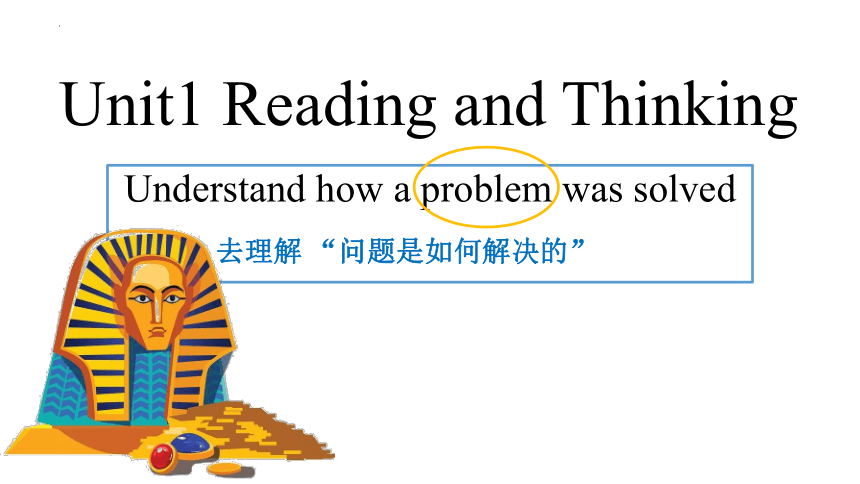 | |
| 格式 | pptx | ||
| 文件大小 | 27.6MB | ||
| 资源类型 | 教案 | ||
| 版本资源 | 人教版(2019) | ||
| 科目 | 英语 | ||
| 更新时间 | 2024-04-18 12:16:01 | ||
图片预览


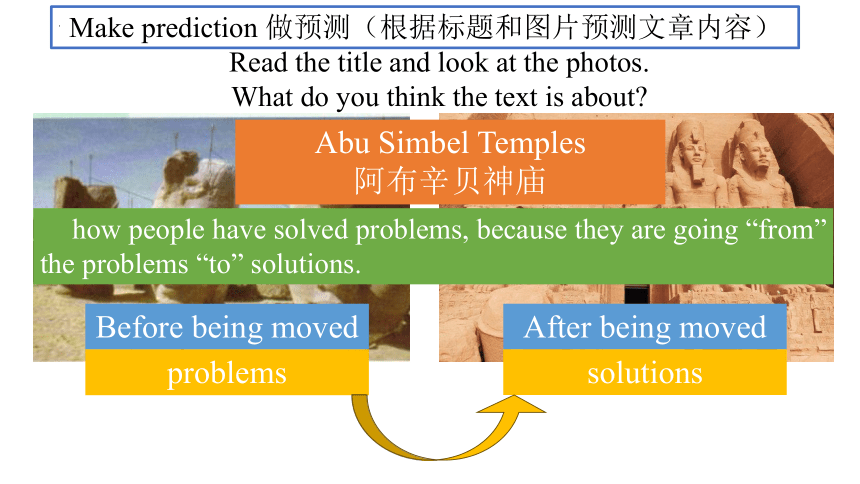
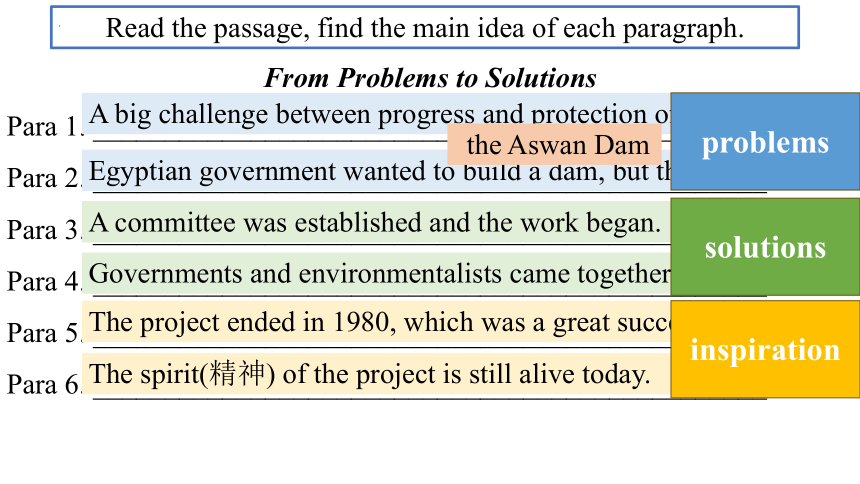
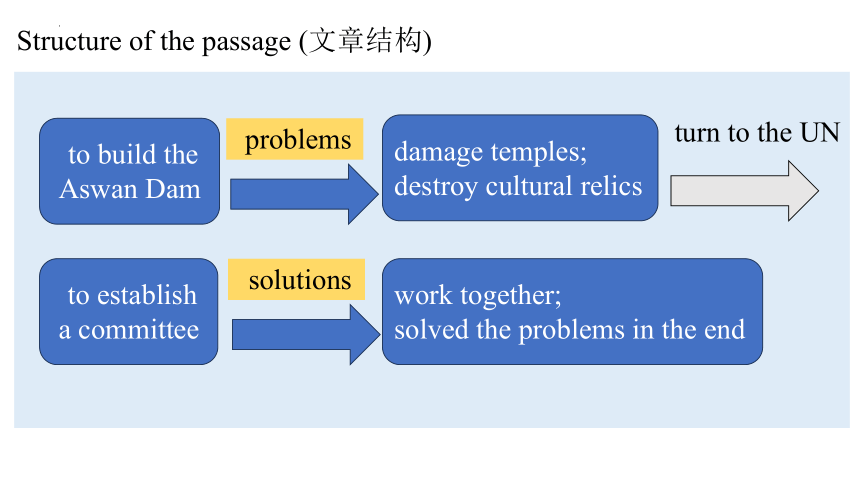
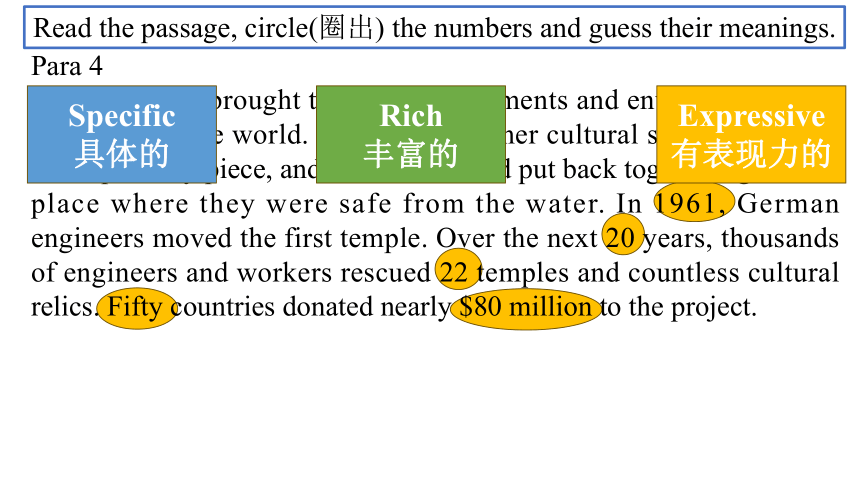
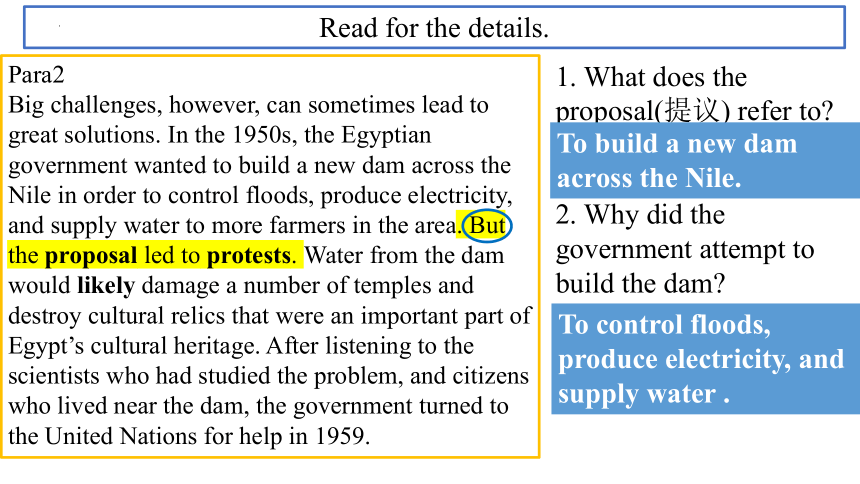
文档简介
(共17张PPT)
Unit1 Reading and Thinking
Understand how a problem was solved
去理解 “问题是如何解决的”
Read the title and look at the photos.
What do you think the text is about
Make prediction 做预测(根据标题和图片预测文章内容)
Abu Simbel Temples
阿布辛贝神庙
Before being moved
After being moved
problems
solutions
how people have solved problems, because they are going “from” the problems “to” solutions.
Read the passage, find the main idea of each paragraph.
From Problems to Solutions
Para 1. _______________________________________________
Para 2. _______________________________________________
Para 3. _______________________________________________
Para 4. _______________________________________________
Para 5. _______________________________________________
Para 6. _______________________________________________
A big challenge between progress and protection of cultural relics.
Egyptian government wanted to build a dam, but there’s problems.
A committee was established and the work began.
Governments and environmentalists came together.
The project ended in 1980, which was a great success.
The spirit(精神) of the project is still alive today.
the Aswan Dam
problems
solutions
inspiration
Structure of the passage (文章结构)
to build the Aswan Dam
damage temples; destroy cultural relics
problems
turn to the UN
to establish a committee
solutions
work together;
solved the problems in the end
Para 4
The project brought together governments and environmentalists from around the world. Temples and other cultural sites were taken down piece by piece, and then moved and put back together again in a place where they were safe from the water. In 1961, German engineers moved the first temple. Over the next 20 years, thousands of engineers and workers rescued 22 temples and countless cultural relics. Fifty countries donated nearly $80 million to the project.
Read the passage, circle(圈出) the numbers and guess their meanings.
Specific
具体的
Rich
丰富的
Expressive
有表现力的
Para2
Big challenges, however, can sometimes lead to great solutions. In the 1950s, the Egyptian government wanted to build a new dam across the Nile in order to control floods, produce electricity, and supply water to more farmers in the area. But the proposal led to protests. Water from the dam would likely damage a number of temples and destroy cultural relics that were an important part of Egypt’s cultural heritage. After listening to the scientists who had studied the problem, and citizens who lived near the dam, the government turned to the United Nations for help in 1959.
1. What does the proposal(提议) refer to
2. Why did the government attempt to build the dam
Read for the details.
To build a new dam across the Nile.
To control floods, produce electricity, and supply water .
Read para 3 & 4, complete(完成) the timeline(时间线).
1959
1960
1961
Over the next 20 years
1980
The government asks the UN for help.
The project starts.
The first temple is moved.
The temples and cultural relics are being rescued.
The projects is completed
1959
1960
1961
Over the next 20 years
1980
The government asks the UN for help.
The project starts.
The first temple is moved.
The temples and cultural relics are being rescued.
The projects is completed
What help did the UN offer
A committee
1959
1960
1961
Over the next 20 years
1980
The government asks the UN for help.
The project starts.
The first temple is moved.
The temples and cultural relics are being rescued.
The projects is completed
How were the temples and other cultural sites saved
They were taken down piece by piece and moved to other places where they would be safe from the water.
1959
1960
1961
Over the next 20 years
1980
The government asks the UN for help.
The project starts.
The first temple is moved.
The temples and cultural relics are being rescued.
The projects is completed
How long did it take to complete the project
20 years
Para 5
When the project ended in 1980, it was considered a great success. Not only had the countries found a path to the future that did not run over the relics of the past, but they had also learnt that it was possible for countries to work together to build a better tomorrow.
team spirit
Para 6
The spirit of the Aswan Dam project is still alive today. Perhaps the best example is shown by UNESCO, which runs a programme that prevents world cultural heritage sites around the world from disappearing. If a problem seems too difficult for a single nation, the global community can sometimes provide a solution.
Countries in the world can _____________ to solve a difficult problem.
work together
Union is strength.
Cultural heritage protection
world cooperation
(合作)
So what is the spirit of the
Aswan Dam project
International cooperation.
Complete the news report, suggest a suitable title.
__________________________________________
In a speech today, a scientist gave her view on the new ________. She said that ________ is important and our area needs economic ___________ as well. But she added, “we should not accept if it puts our cultural ________ in danger. We must protect the ________ and make sure that no ________ is done.” before she ended her speech, the scientist suggested that we need to ________ a committee of experts to ________ the cultural heritage and ________ from being harmed.
development progress proposal preserve
temple damage heritage establish prevent
proposal
progress
development
heritage
temples
damage
establish
preserve
prevent
Scientist Says Progress Shouldn’t Damage Cultural Heritage
What were the solutions to the problem of building the Aswan Dam
A lot of money was spent to protect the temples. Do you think it was worthwhile Why or why not
Discussion
A debate game(辩论赛)
A lot of money and time were spent in protecting cultural heritage all around the world. Do you think it worthwhile or not
Affirmative 正方
Negative 反方
It is worthwhile to protect cultural heritage because...
It is not worthwhile to protect cultural heritage because...
It's our responsibility!
History and culture are the soul of a city and we should cherish(珍视) the city's historical and cultural heritage as our own lives.
Unit1 Reading and Thinking
Understand how a problem was solved
去理解 “问题是如何解决的”
Read the title and look at the photos.
What do you think the text is about
Make prediction 做预测(根据标题和图片预测文章内容)
Abu Simbel Temples
阿布辛贝神庙
Before being moved
After being moved
problems
solutions
how people have solved problems, because they are going “from” the problems “to” solutions.
Read the passage, find the main idea of each paragraph.
From Problems to Solutions
Para 1. _______________________________________________
Para 2. _______________________________________________
Para 3. _______________________________________________
Para 4. _______________________________________________
Para 5. _______________________________________________
Para 6. _______________________________________________
A big challenge between progress and protection of cultural relics.
Egyptian government wanted to build a dam, but there’s problems.
A committee was established and the work began.
Governments and environmentalists came together.
The project ended in 1980, which was a great success.
The spirit(精神) of the project is still alive today.
the Aswan Dam
problems
solutions
inspiration
Structure of the passage (文章结构)
to build the Aswan Dam
damage temples; destroy cultural relics
problems
turn to the UN
to establish a committee
solutions
work together;
solved the problems in the end
Para 4
The project brought together governments and environmentalists from around the world. Temples and other cultural sites were taken down piece by piece, and then moved and put back together again in a place where they were safe from the water. In 1961, German engineers moved the first temple. Over the next 20 years, thousands of engineers and workers rescued 22 temples and countless cultural relics. Fifty countries donated nearly $80 million to the project.
Read the passage, circle(圈出) the numbers and guess their meanings.
Specific
具体的
Rich
丰富的
Expressive
有表现力的
Para2
Big challenges, however, can sometimes lead to great solutions. In the 1950s, the Egyptian government wanted to build a new dam across the Nile in order to control floods, produce electricity, and supply water to more farmers in the area. But the proposal led to protests. Water from the dam would likely damage a number of temples and destroy cultural relics that were an important part of Egypt’s cultural heritage. After listening to the scientists who had studied the problem, and citizens who lived near the dam, the government turned to the United Nations for help in 1959.
1. What does the proposal(提议) refer to
2. Why did the government attempt to build the dam
Read for the details.
To build a new dam across the Nile.
To control floods, produce electricity, and supply water .
Read para 3 & 4, complete(完成) the timeline(时间线).
1959
1960
1961
Over the next 20 years
1980
The government asks the UN for help.
The project starts.
The first temple is moved.
The temples and cultural relics are being rescued.
The projects is completed
1959
1960
1961
Over the next 20 years
1980
The government asks the UN for help.
The project starts.
The first temple is moved.
The temples and cultural relics are being rescued.
The projects is completed
What help did the UN offer
A committee
1959
1960
1961
Over the next 20 years
1980
The government asks the UN for help.
The project starts.
The first temple is moved.
The temples and cultural relics are being rescued.
The projects is completed
How were the temples and other cultural sites saved
They were taken down piece by piece and moved to other places where they would be safe from the water.
1959
1960
1961
Over the next 20 years
1980
The government asks the UN for help.
The project starts.
The first temple is moved.
The temples and cultural relics are being rescued.
The projects is completed
How long did it take to complete the project
20 years
Para 5
When the project ended in 1980, it was considered a great success. Not only had the countries found a path to the future that did not run over the relics of the past, but they had also learnt that it was possible for countries to work together to build a better tomorrow.
team spirit
Para 6
The spirit of the Aswan Dam project is still alive today. Perhaps the best example is shown by UNESCO, which runs a programme that prevents world cultural heritage sites around the world from disappearing. If a problem seems too difficult for a single nation, the global community can sometimes provide a solution.
Countries in the world can _____________ to solve a difficult problem.
work together
Union is strength.
Cultural heritage protection
world cooperation
(合作)
So what is the spirit of the
Aswan Dam project
International cooperation.
Complete the news report, suggest a suitable title.
__________________________________________
In a speech today, a scientist gave her view on the new ________. She said that ________ is important and our area needs economic ___________ as well. But she added, “we should not accept if it puts our cultural ________ in danger. We must protect the ________ and make sure that no ________ is done.” before she ended her speech, the scientist suggested that we need to ________ a committee of experts to ________ the cultural heritage and ________ from being harmed.
development progress proposal preserve
temple damage heritage establish prevent
proposal
progress
development
heritage
temples
damage
establish
preserve
prevent
Scientist Says Progress Shouldn’t Damage Cultural Heritage
What were the solutions to the problem of building the Aswan Dam
A lot of money was spent to protect the temples. Do you think it was worthwhile Why or why not
Discussion
A debate game(辩论赛)
A lot of money and time were spent in protecting cultural heritage all around the world. Do you think it worthwhile or not
Affirmative 正方
Negative 反方
It is worthwhile to protect cultural heritage because...
It is not worthwhile to protect cultural heritage because...
It's our responsibility!
History and culture are the soul of a city and we should cherish(珍视) the city's historical and cultural heritage as our own lives.
